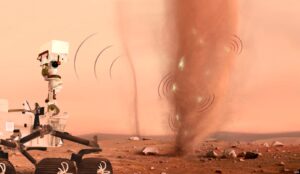Soutenance de thèse
Lucas Lange
LMD
Modeling the Dynamics of Water and CO2 Ice on the Planet Mars
Résumé
Mars is surrounded by a thin atmosphere composed mostly of CO2 with a small amount of water. Every night and every winter, CO2 and water can locally condense as frost. In the geologically recent past, when the obliquity of Mars was larger, the Martian atmosphere was enriched in water and a perennial mantle of water ice formed from the poles to the mid-latitudes. When the obliquity decreased again, these ices sublimated and got buried under a lag deposit in the Martian subsurface, while much of the atmospheric CO2 condensed at the poles to form massive glaciers. Today, we can observe the remains of these periods via the water ice buried in the subsurface at mid-latitudes and the perennial CO2 cap at the South Pole. This thesis aims to improve our understanding of the stability and dynamics of these ices over time, from the diurnal cycle to the million-year scale. I used space observations and, even more, numerical models such as the global climate model « Mars Planetary Climate Model » (PCM) and the new « Planetary Evolution Model » (PEM) for which I actively invested to develop new capabilities.
In a first study, by comparing the different pressure data acquired on the surface of Mars by space probes over the last 50 years, I proved that the average mass of the Martian atmosphere had not varied at these scales and therefore that the perennial CO2 cap had a neutral mass balance. I then showed that the diurnal cycle of CO2 frost formation in dusty areas could prevent dust from aggregating, maintaining the presence of reservoirs of mobilizable dust on the surface.
At the same time, I developed a new numerical tool for modeling microclimates on Martian slopes within the PCM and then the PEM.This tool is able to predict the presence of Martian ice on cold slopes in agreement with the detections from orbit. In a dedicated study, using observations from the THEMIS visible and thermal camera and this new model, I showed that the water frost accumulating on these slopes cannot melt in the current climate. It may eventually form brines if this frost is in contact with a significant amount of salts.
I then studied the stability of water ice in the subsurface. In particular, I proved that buried water ice at tropical latitudes under poleward slopes was not stable. The presence of such a buried water ice had previously been presented as essential to explain the absence of seasonal CO2 ice on these slopes, because of its high thermal inertia. However, my model showed that this absence of CO2 ice could also be explained by atmospheric heat transport, previously neglected. By adapting a new comprehensive model of exchange between permafrost and the Martian atmosphere, I revisited the effect of the water cycle and near-surface atmospheric conditions on the stability of buried ice. In parallel, we reconstructed the history of buried water ice in the mid-latitude subsurface and suggested that it may be a remnant of the last ice ages of 630,000 years ago. Finally, as for the surface frost, I showed that this buried water ice could not melt, even under the most favorable conditions we could imagine for Mars: the case where a ground flow suddenly exposes the underground ice to solar heating.
In a final study, using the new « Planetary Evolution Model », I simulated the formation of CO2 glaciers when the entire atmosphere condenses in the polar regions during periods of low obliquity. By decreasing the obliquity from the current value of 25.2° to 15°, I showed that the mean pressure drops to a value of 250 Pa. The humidity of the atmosphere is reduced to a few precipitable microns. Massive CO2 glaciers form on poleward slopes at high latitudes. Despite the loss of more than half of the Martian atmosphere, CO2 remains the major component. This work constitutes a new step in our understanding of Martian paleoclimates and in particular of the geological activity induced by recent climatic variations.
Informations supplémentaires
Lieu
Sorbonne Université
Campus Pierre et Marie Curie
4, place Jussieu Paris 5e
Amphithéâtre Charpak
Visio
https://cnrs.zoom.us/j/96959598917?pwd=okslHXTeig27EX6TsoihB4XHRAGZOv.1
Composition du jury
- Paul Hayne (LASP) – Rapporteur
- Sylvestre Maurice (IRAP) – Rapporteur
- Alice Le Gall (LATMOS) – Examinatrice
- Nicolas Mangold (LPG) – Examinateur
- Franck Montmessin (LATMOS) – Examinateur
- Cédric Pilorget (IAS) – Examinateur
- Cathy Quantin (LGL) – Examinatrice
- François Forget (LMD) – Directeur de thèse





